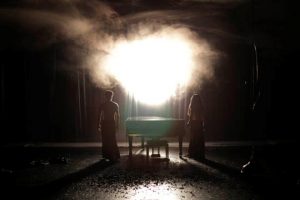The collaboration between pianist Tomoko Mukaiyama and choreographer Nicole Beutler in the performance 'Shirokuro', seen last week at the Holland Festival, provides a beautiful perspective on two piano sonatas by Galina Ustvolskaya. 'Shirokuro' means black and white in Japanese. Despite strong visuals and impressive co-protagonists on stage, the Russian composer's absolute music is never explained and therefore retains its sheer power.
Het ‘dansconcert’ begint met een langzame introductie van elementen. Een donkere, onpeilbare ruimte opent zich. Het ruist en resoneert daar als in het universum. Midden op het toneel staat een enorme vleugel, waarvan alleen het front werkelijk te zien is. Deze lijkt zo meer op een werktafel, een wat groot uitgevallen secretaire of een huisaltaar. Belichter Jean Kalman voorzag de vloer ook nog van enige witte neonstreepjes, die het intieme duister alsnog desolaat en statisch maken.
Mukaiyama komt op als een muppet-sjamaan. Gebogen gesticulerend of op handen en voeten beweegt zij langzaam voorbij de vleugel. Haar lengte en blote bast blijven verborgen achter een inmense, zwarte pruik. Met een neonbuis in haar handen is ze even een Jedi, hoewel de fijn geplooide rok die van haar middel valt meer aan een rouwkostuum doet denken. Als een duveltje uit een doosje bespringt de pianiste uiteindelijk de pianokruk en slaat de eerste toetsen aan. Niets hier doet nog denken aan de plechtigheid van een klassiek concert. Alles verwijst naar een heel andere, veel oudere wereld, waar leven en dood als vanzelfsprekend verbonden zijn met ongenaakbare eeuwigheid.

Intens kijken en toch weinig zien helpt bij het luisteren. Tomoko Mukaiyama speelt de vijfde pianosonate soms haast swingend. De vleugel klinkt geprepareerd, maar het is de lengte van de snaren van de Fazioli, laat ik mij na afloop vertellen, en de aanslag, de manier van spelen, die het geheel iets ‘on-pianistisch’ geven. De dreunende toonclusters van Oestvoslkaja – hun impact trekt een gevoelsvaccuüm: het denken vergaat je, elk gevoel wordt opgevroten, er rest slechts overgave – maken van de pianiste een monumentale drummer, al zijn er in Pianosonate nr. 5 nog heel wat losse noten en wandelende frases, die iets van een lyrisch gevoel doen terugkeren.
Pas na twintig minuten is er zoveel licht op de toetsen, dat we de handen van Mukaiyama aan het werk zien. De tl-s gaan uit en ik moet aan Svjatoslav Richter denken, die ook graag in het donker speelde. Dan pas komt danser en tegenspeler Mitchell-lee van Rooij op. Ook hij blijft aanvankelijk verborgen onder zijn kostuum. Het fladdert met hem mee en geeft zijn rijzige gestalte ook iets onbeholpens. Dansend op de beat en niet anders dan op de beat van Oestvolskaja, hamert en houwt ook hij nu stukken tijd. Alles is in volle beweging, zonder dat de performers als mens op de voorgrond treden. Hun aanwezigheid is eerder voelbaar dan zichtbaar. De ruimte van het toneel wisselt subtiel van toon. Het tegenlicht van Jean Kalman speelt met scherpte-diepte. Soms blijft er van de protagonisten niet meer dan een stralende contour over, terwijl binnen de lijnen van hun profiel het zwarte niets je aangaapt en de ondoordringbaarheid van de muziek gespiegeld wordt in een medogenloos beeld.

Dringend, dwingend, heel soms swingend, is de kaalslag die zo plaatsvindt op het toneel, zeker met de inzet van Sonate nr. 6. Met elke nieuwe paukenslag breidt de leegte zich uit. De twee figuren op het podium lijken, ondanks hun intrense optreden, verweesd, zoals zij rondwaren in een brutaal landschap zonder verhaal. En dan is er ineens een klein beetje Schumann, in een glorend bad van licht en goud en rust. Mitchell-lee van Rooij krijgt vleugels. Het intense gevecht wordt ingewisseld voor een lyrisch vervallende, fysieke werveling door de ruimte.
Als de vleugel wordt gesloten en het gloren zich verengt tot een enkel licht hoog achter op het toneel, manifesteert zich ook daar iets uit de negentiende eeuw. Van Rooij en Mukaiyama aan weerszijden van het zwarte monster lijken nachtwakers in een burgerkamer gedrenkt in rouw. Er verspreid zich een intense droefheid over het podium, door Mukaiyama nog eens bevestigd in haar ijle interpretatie van Schumann’s Die Lotosblume. De synthetisch bewerkte klanken zijn trashy, worden met het moment scherper en scheller, werkelijk onverdraaglijk. Leegte, rouw, onuitputtelijke onuitspreekbaarheid, een stille kracht die alleen in eenzaamheid te dragen is; het a-sociale dat de muziek van Oestvoslkaja zo krachtig maakt, klinkt na in deze ruige interpretatie van twee vrouwen, die het wagen om met theatrale middelen vorm te geven aan de stompzinnigheid van intens verdriet. Verbijsterd laten zij de zaal achter. Heel goed gedaan.
Documentaire ‘Schreeuw in het heelal’ van Joseé Voormans, VPRO, 2005, over Galina Ustvolskaya (1919-2006):
